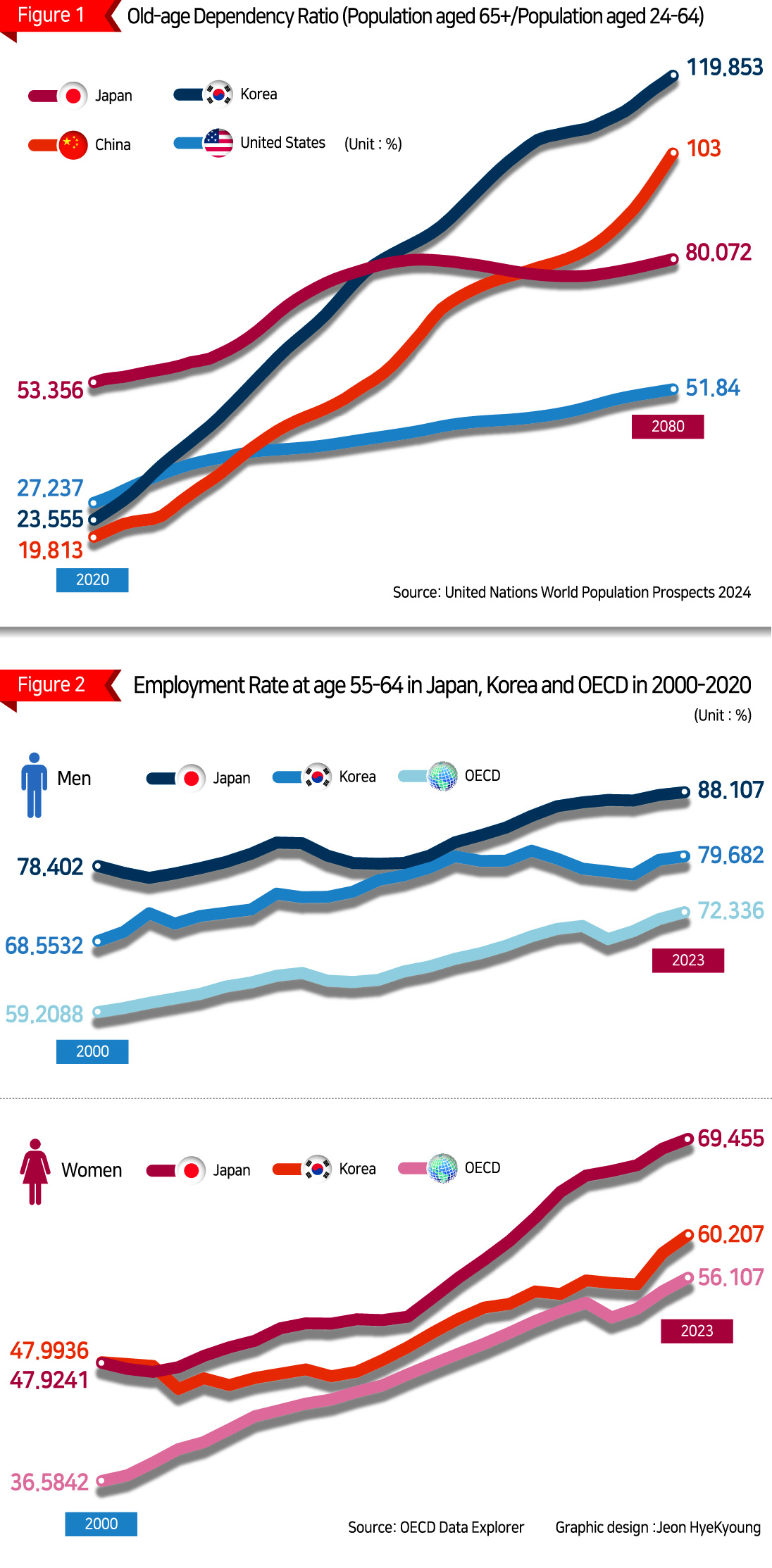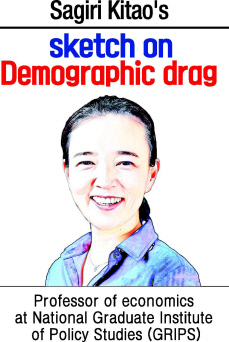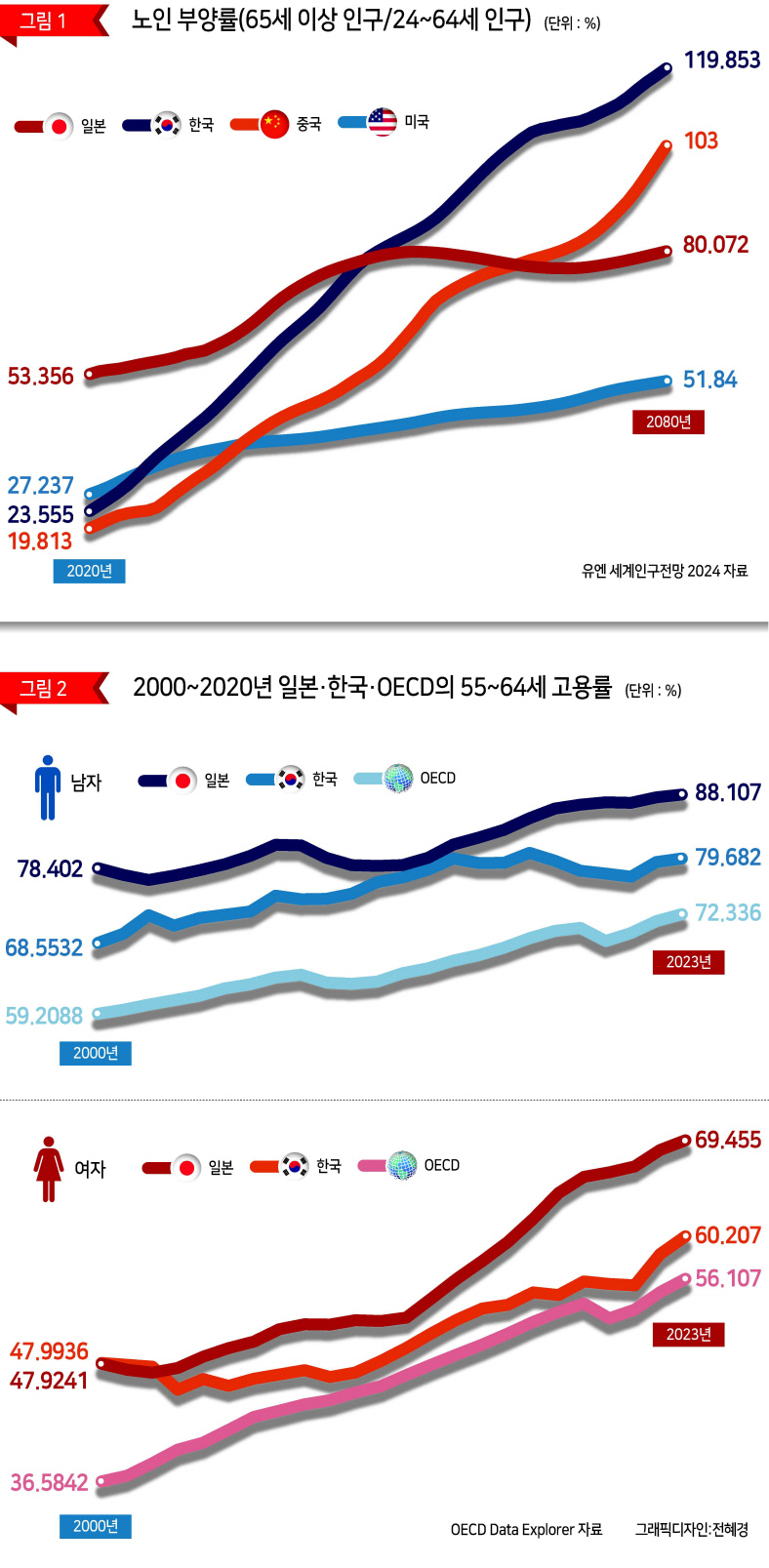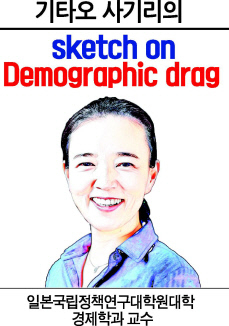

The demographic structure in many countries is undergoing a significant transformation, driven by rapidly declining fertility rates and increasing longevity. This shift results in a growing proportion of elderly individuals, which in turn places substantial pressure on fiscal balance due to soaring public expenditures needed to finance age-related social insurance programs. As illustrated in Figure 1, the old-age dependency ratio ― which is the ratio of individuals aged 65 and above to those aged between 20 and 64 ― is rising globally. This increase is particularly pronounced in Asian countries such as Japan, Korea and China.
[FIGURE 1]
In Japan, three social insurance programs ― public pensions, health insurance and long-term care insurance ― are driving the growth of public expenditures. According to the National Institute of Population and Social Security Research (IPSS), total expenditures for the social insurance system accounted for less than 10% of GDP until 1980, but have steadily risen, reaching 25% of GDP in 2021. Of this total, 40% is allocated to public pensions, 34% to health insurance, and 8% to long-term care insurance, making up more than 80% of the entire social insurance spending. These expenditures are expected to continue growing over the coming decades until the old-age dependency ratio stabilizes. The situation may become more challenging in Korea or China, where the share of the elderly is projected to rise for a longer period, unless there are drastic change in population dynamics.
What are the options for the government to cope with the fiscal challenge? If deficits continue to grow, they must be addressed through either raise tax revenues or reducing expenditures.
Raising taxes, particularly by selecting those that minimize economic disruption and distribute the burden widely, is a desirable option from growth perspectives. However, this approach is often politically challenging and may not be feasible. Japan introduced consumption tax of 3% in 1989, gradually increasing it to 10% by 2019. The consumption tax provides a relatively stable source of revenue, as its base fluctuates less with business cycles compared to income taxes, and it is considered less distortionary. Despite these advantages, the consumption tax is extremely unpopular in Japan, likely because it impacts everyone visibly in their daily lives and is considered regressive. Taxes on household earnings are already very high, especially when accounting for the substantial social insurance premiums imposed on workers‘ earnings.
Reducing social insurance benefits is also challenging, particularly given the demographic structure, which is already skewed towards the elderly. These individuals are the primary beneficiaries of social insurance programs, making it politically difficult for elected officials to advocate for reforms that would negatively impact their wallets.
Implementing policies to raise fertility and reduce the dependency ratio is an obvious solution, but achieving this is highly uncertain. Many countries have struggled to find effective ways to boost fertility rates, often discovering that costly attempts yield little success. Even countries such as Finland and Norway, which have a history of family-friendly policies and excellent gender balance (ranking 2nd and 3rd in the Global Gender Gap Report, respectively) are struggling with low fertility rates. Furthermore, even if some policies prove effective, it would take at least a few decades for the children born today to begin contributing significantly to tax revenues.
| ||
| For the first time in Japanese history, the population aged 80 or older is expected to make up 10 percent of the total population, according to data released by the Japanese government in 2023. As of Sept. 15, Japan had about 36.23 million people aged 65 or older, the data showed. This was 29.1 percent of the total population, a record increase of 0.1 percentage points from the previous year. An old man is sitting on a pier in Tomonoura, Hiroshima Prefecture. [EPA] |
Another promising approach, if successful, would be to raise household earnings, thereby expanding the tax base without raising tax rates. In Japan, the employment rate of prime-age men is very high, leaving little room for further growth. The employment rate for women is also relatively high, with about 79% of women aged 20-64 working in Japan, compared to the OECD average of 70% and Korea‘s 67%. However, there is a significant earnings gap between men and women. Narrowing this gap could substantially expand the tax base.
This large earnings gap is largely driven by the low earnings of married women, many of whom work as contingent workers rather than regular employees. These contingent positions often come with lower pay, temporary contracts, and higher susceptibility to layoffs. Additionally, the government provides various tax benefits for dependent low-income spouses, leading many married women to limit their work hours and opt for contingent jobs to remain eligible for these benefits. These outdated policies significantly distort women‘s incentives to work and accumulate skills. Removing such policies would encourage more women to pursue, higher-paying jobs, thereby increasing their earnings and expanding the tax base.
Another potential area for earnings growth is the employment of late middle-aged and elderly individuals. As shown in Figure 2, the employment rates of this group have increased during the last few decades, but they still lag behind those of younger age groups. Empirical studies find that labor supply elasticity, which measures how individuals respond to changes in after-tax wages, increases with age. This suggests that the labor supply and earnings of middle-aged and older individuals are highly sensitive to labor market policies and wage growth.
| ||
| A picture of workers sharpening scissors and kitchen knives on a whetstone at a work center for senior citizens in Tokyo. Silver-haired workers are seen everywhere in Japan these days, from wrinkled men waving luminous sticks at construction sites to cashier clerks and elderly caregivers. In Japan, where about 27% of the country''s population is 65 or older, an atmosphere is spreading to encourage senior workers to continue working and pass on their skills and experiences to younger ones. [AFP] |
[FIGURE 2]
Several factors have likely contributed to the recent rise in the employment of elderly individuals in Japan.
First, the eligibility age for receiving full pension benefits has increased from 60 to 65. This policy change has presumably encouraged higher participation rates among individuals in their early 60s. However, this policy alone does not account for the overall increase in the elderly employment, as employment rates have also risen for those in their late 60s and even 70s. For example, the employment rate for men aged 70-74 increased from less than 30% in 2005 to 43% in 2023.
Second, the retirement age set by companies has increased over the last two decades. In Japan, companies can set their own mandatory retirement age for employees, but regulations regarding this age have evolved towards encouraging longer employment since the late 1990s. In 1998, companies were required to set the retirement age at or above 60. In 2006, the government mandated that firms retain workers until age 65 by either extending or abolishing the retirement age or offering a different job within the company. Starting in 2021, firms are required to make efforts to retain workers until age 70.
In addition to retirement-related policies and regulations, several other factors have contributed to the increased employment of elderly individuals in Japan. Increased longevity, combined with decades of economic stagnation, has necessitated that some elderly people continue working to prepare for longer retirement periods. Research has also found that improvements in health conditions have been instrumental in supporting the postponement of retirement. Additionally, the rise in demand for workers in the service sectors has expanded the types of jobs available to the elderly.
While it is a positive trend that individuals are working longer, average wages and earnings drop sharply after their 50s. The decline is partly due to the seniority system with its rigid age-dependent wage structure employed by many traditional companies, and also due to insufficient investment in human capital and skill upgrading. Workers have weak incentives to develop versatile skills if their efforts are not reflected in their salaries, leading to a significant wage decline upon mandatory retirement. Policies should also address these issues, as ensuring sufficient tax revenues requires not just high employment rates, but also high earnings for each worker, including women and the elderly.


고령화와 재정 문제
현재 많은 나라가 급격한 출생률 감소와 수명 연장으로 인구의 상당한 구조적 변화를 겪고 있다. 이 변화는 고령 인구 비율의 확대로 이어지고, 이는 다시 고령화와 관련된 사회보험제도에 필요한 공적 지출을 급격히 증가시켜 재정 수지에 상당한 압박을 가한다. [그림 1]에 나타나 있듯, 20~64세 인구 대비 65세 이상 인구의 비율을 뜻하는 노인 부양률이 전 세계적으로 높아지는 추세다. 증가세는 일본, 한국, 중국 등 아시아에서 특히 두드러진다.
일본은 3대 사회보험제도, 즉 공적 연금, 건강보험 그리고 장기 요양보험이 공적 지출의 증가를 이끌고 있다. 일본 국립사회보장·인구문제연구소(IPSS)에 따르면, 사회보험제도의 합계 지출액은 1980년까지 GDP의 10%를 밑돌았지만, 이후 꾸준히 증가해 2021년에는 GDP의 25%에 이르렀다. 이 중 40%는 공적 연금, 34%는 건강보험, 그리고 8%는 장기 요양보험으로, 전체 사회보험 지출의 80% 이상을 차지한다. 이 지출은 노인 부양률이 안정세에 접어들 때까지 앞으로 수십 년간 꾸준히 증가할 것으로 예상된다. 고령자 비율이 더 오래 증가할 것으로 예측되는 한국과 중국의 경우, 인구 역학적으로 급격한 변화가 없는 한 상황이 이보다 더 어려울 수도 있다.
그렇다면 재정적 문제를 감당하기 위해 정부가 쓸 수 있는 카드는 무엇이 있을까? 적자가 계속 쌓인다면, 세수 확대나 지출 삭감을 통해 문제를 해결해야 할 것이다.
증세, 특히 경제적 혼란을 최소화하고 부담은 골고루 분산시키는 증세가 성장 면에서 바람직한 선택지다. 그러나 이 방식은 정치적으로 쉽지 않을 공산이 크다. 실현 가능성도 작을 수 있다. 일본은 1989년에 3%의 세율로 소비세를 도입하고, 이후 2019년까지 10%로 차츰 세율을 인상해 왔다. 소득세에 비해 경기 순환의 영향을 덜 받고 왜곡도 더 적다고 인식되는 만큼 소비세는 비교적 안정적인 조세 수입이다. 이런 장점에도 불구하고 소비세는 일본에서 극도로 인기가 없다. 아마도 모두의 일상에 가시적인 영향을 주는 데다 역진세의 성격을 띤다고 보기 때문일 것이다. 특히 근로 소득에 부과되는 사회보험료가 상당하다는 점을 감안하면, 가구 소득에 대한 세금은 이미 무척 높다.
고령자 쪽으로 기울어져 버린 인구 구조상, 사회보험 급여를 축소하는 것도 어렵다. 사회보험제도의 주요 수혜자가 고령층인 이상 선출직 공무원이 이들의 지갑에 나쁜 영향을 미치는 개혁을 지지하기란 정치적으로 어렵다.
출생률을 높이고 부양률을 낮추는 정책을 이행하는 것이 확실한 해결책이겠지만, 달성 여부는 극히 불확실하다. 많은 나라가 출생률을 높이는 효과적인 방안을 찾으려 애썼지만, 값비싼 노력에 비해 결과는 미미한 경우가 많았다. 심지어 핀란드나 노르웨이처럼 전통적으로 가족 친화적인 정책과 훌륭한 성비 균형(세계 젠더 격차 보고서에서 각각 2위와 3위를 차지한다)을 자랑하는 나라조차 낮은 출생률로 애를 먹고 있다. 게다가 설령 어떤 정책의 효과가 입증되더라도, 지금 태어난 아이들이 자라 세수에 상당한 기여를 하기까지는 적어도 수십 년 이상을 기다려야 한다.

또 한 가지, 만일 성공한다면 효과가 있을 만한 대책은 가구 소득을 증가시켜 세율을 높이지 않으면서 세원(Tax base)을 늘리는 것이다. 일본은 핵심 노동연령(Prime-age)에 속한 남성의 고용률이 매우 높아 더 성장할 여력이 거의 없다. 여성 고용률 역시 20~64세 여성 기준 79%로, 평균 70%인 OECD와 67%인 한국에 비해 비교적 높다. 그러나 남녀 간 소득 격차는 꽤 크다. 이 격차를 줄인다면 세원이 크게 늘어날 수 있을 것이다.
소득 격차가 큰 이유는 주로 기혼 여성의 소득이 낮은 탓이다. 기혼 여성 상당수는 정규직이 아닌 비정규직 노동자로 일하고 있다. 이런 비정규직의 경우, 흔히 임금이 더 낮고, 임시 계약직이며, 정리해고 대상이 될 가능성이 더 높다. 게다가 피부양, 저소득 배우자에게는 정부에서 다양한 세제 혜택이 제공되기 때문에, 많은 기혼 여성이 이런 혜택을 지속적으로 받기 위해 자신의 노동시간을 제한하며 비정규직을 선택하고 있다. 이런 낡은 정책은 여성의 근로 및 기술 개발 동기를 현저히 왜곡시킨다. 이런 정책을 철폐한다면 더 많은 여성이 고소득 일자리를 찾게 될 것이고, 결과적으로 그들의 소득이 증가하며 세원이 확대될 것이다.
소득 증가를 꾀할 만한 또 다른 분야는 중년 후기 및 노년기 성인의 채용이다. [그림 2]에 나타나 있듯이, 이 집단의 고용률은 지난 몇 십년간 증가해 왔지만, 젊은 연령대에 비해서는 여전히 뒤처져 있다. 여러 실증 연구에 따르면, 개인이 세금 공제 후 임금의 변화에 어떻게 반응하는지 측정하는 노동 공급 탄력성은 나이가 들수록 증가한다. 즉, 중년 이상 성인의 노동 공급과 소득은 노동시장 정책과 임금 상승률에 매우 민감하게 반응한다는 것을 알 수 있다.

일본에서 최근 고령층의 고용률이 증가한 이유로는 몇 가지를 추측해 볼 수 있다.
첫째, 완전 연금(Full pension)을 수령할 수 있는 나이가 60세에서 65세로 상향됐다. 짐작건대 이 정책 변화가 60대 초반 성인의 노동 참여율을 높이는 원인이 되었을 것이다. 그러나 이 정책만 가지고 전반적인 노인 고용률 증가 현상을 모두 설명할 수는 없다. 고용률은 60대 후반, 심지어 70대 초반에서도 상승했기 때문이다. 가령, 70~74세 남성의 고용률은 2005년 30% 미만에서 2023년 43%로 증가했다.
둘째, 기업이 설정하는 정년이 지난 20년간 높아졌다. 일본 기업들은 자율적으로 직원의 정년을 정할 수 있는데, 이와 관련된 규정이 1990년대 말부터 고용 기간을 확대하는 쪽으로 바뀌어 왔다. 1998년에는 기업이 정년을 60세 이상으로 정해야 했다. 반면 2006년에는 정부에서 기업이 정년을 연장 혹은 폐지하거나 사내의 다른 일자리를 알선해 직원의 고용을 65세까지 유지하도록 의무화했다. 2021년부터는 근로자에게 70세까지 고용을 보장하도록 노력해야 할 의무가 기업에 부여됐다.
은퇴 관련 정책이나 규정 외에도 일본의 노인 고용률 증가에 일조한 요인은 몇 가지가 더 있다. 수명 연장이 수십 년에 걸친 경기침체와 맞물리면서, 일부 고령층은 더 길어진 은퇴 기간에 대비해 일을 계속할 수밖에 없게 된 것이다. 각종 연구를 보면 건강 상태의 개선도 은퇴를 지연시키는 데 중요한 역할을 한 것으로 나타난다. 더불어 서비스 부문의 노동자 수요가 증가하면서 고령층이 취업할 수 있는 일자리 유형도 늘어났다.
개인이 더 오래 일한다는 것은 긍정적인 추세지만, 평균 임금과 소득은 50대가 지나면서 급격히 꺾인다. 전통적 기업 중 상당수가 연공서열형 임금 구조를 채택하고 있고 인적 자본과 기술(Skill) 향상에 대한 투자가 부족하다는 데서 어느 정도 그 이유를 찾을 수 있다. 개인의 노력이 임금에 반영되지 않으면, 노동자는 다양한 기술을 개발할 동기가 약해지고, 이는 곧 정년 퇴직 후 임금이 급락하는 결과를 낳는다. 이런 문제는 정책을 통해 풀어나가야 한다. 충분한 세수 확보를 위해서는 고용률도 높아야 하지만, 여성과 노인 할 것 없이 모든 노동자가 높은 수입을 올려야 하기 때문이다.
bonsang@heraldcorp.com















